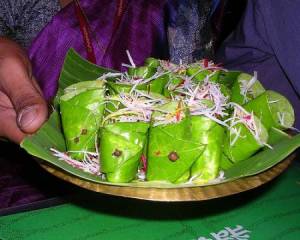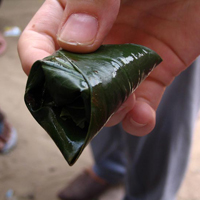My first thought for Steve’s Weird Food: India was a nice but unexpected dessert item called petha. It’s the flesh of unripened pumpkin, cut into bite-sized pieces and then cooked in a sugar syrup. (Pretty much all desserts in India involve either lashings of sugar syrup or improbable quantities of sweetened condensed milk or pounds of ghee – clarified butter. It’s my kind of place). Petha was nice, and odd, and I thought it would do nicely as a Weird Food. That’s until Akshay introduced us to pan (pronounced pahhhn, with the long A sound like in “wash”). (Also, the Wikipedia article about it spells it paan, but notes that the Hindi spelling is pan.)
First, an apology. When I decided that pan was going to be SWF for India, Akshay went out specially and bought me a fresh one so I could take some good photos and show you what it’s all about. I carefully tucked it away in a bag of other snacks and then promptly left the whole bag in the van that drove us from the Nepali-Indian border (I also lost a big bottle of water and a Dairy Milk and two bags of Masala Munch which is a yummy snack food that tastes a lot like curry Cheezies). Any photos here are crummy ones I dug up on the internet that don’t really look especially like what I had.
 But back to the pan. As I said, Akshay introduced us to it, during our afternoon cruise in Varanasi. It’s a specialty of the city but I’m not even sure what category of food it would fall into. It’s kind of part snack, part breath-freshener, part chewing tobacco. Some of you might be familiar with the Indian after-dinner practice of having a small spoonful of aniseed and sugar as a breath freshener; I found it sort of like that.
But back to the pan. As I said, Akshay introduced us to it, during our afternoon cruise in Varanasi. It’s a specialty of the city but I’m not even sure what category of food it would fall into. It’s kind of part snack, part breath-freshener, part chewing tobacco. Some of you might be familiar with the Indian after-dinner practice of having a small spoonful of aniseed and sugar as a breath freshener; I found it sort of like that.
Here’s a great excerpt from a website I found when I Googled “Varanasi pan”. It’s such an excellent mashup or English that I include it here without correction. (Note: “Banarasi” is another name for Varanasi.)
Banarasi pan is world famous betel leaves. Banarasi Pan (Betel leaves) to whole world in fresh natural. Banarasi paan which is renowned all over. Paan is also an alternative to mouth refreshner. Banarasi paan is offered with gulkand,grated coconut and dry dates flavers All rolled in an betel leaf. Preparing paan is very artistic, correct proportion of the ingredients make it delicious.With a shelf life ever 4 month, it is an ideal product to served at weddings, parties etc.
The tradition of chewing pan (betel leaf) is deeply rooted in India. From times immemorial, pan has remained a part of sacred Hindu rites and is always offered to the deities. Pan has great significance in the wedding rituals and all other important functions where its offering is a mark of respect for the guests. The earliest known mention of Pan have been found in the inscription found at Mandasor, Madya Pradesh.
Pan popularly known as tambula in Sanskrit is often consumed after the meals as it helps in digestion, also it gives fresh feeling the mouth and relieves the bad breath. Some important facts are that it reduces the blood pressure assists in digestion, relieves hunger, eliminates bad breath, strengthens the teeth and decreases menstrual bleeding. In unani tradition it is used as household remedies.
How could you refuse?
 A bundle of pan is small – fitting neatly into the palm of your hand with lots of room to spare. Inside the bundle is a mixture of aniseed, fennel seed, dried rose petal preserved with sugar, dried rose petal powder, mint, kewra powder and katha paste (two things Akshay didn’t have an English translation for), a small amount of limestone paste and betel nut. The betel nut is softened with water and the whole concoction is wrapped in a betel leaf. All that is then wrapped in another type leaf that’s held shut with a toothpick. You open up the outer wrapper and the bundle inside – leaf and all – is what you eat. The whole bundle is about an inch or an inch and a half square, so it would be a big mouthful to have all at once; we each tore a corner off the one Akshay passed around. It seemed like the kind of thing you’d chew and then spit out, but you are actually meant to swallow it, so swallow we did.
A bundle of pan is small – fitting neatly into the palm of your hand with lots of room to spare. Inside the bundle is a mixture of aniseed, fennel seed, dried rose petal preserved with sugar, dried rose petal powder, mint, kewra powder and katha paste (two things Akshay didn’t have an English translation for), a small amount of limestone paste and betel nut. The betel nut is softened with water and the whole concoction is wrapped in a betel leaf. All that is then wrapped in another type leaf that’s held shut with a toothpick. You open up the outer wrapper and the bundle inside – leaf and all – is what you eat. The whole bundle is about an inch or an inch and a half square, so it would be a big mouthful to have all at once; we each tore a corner off the one Akshay passed around. It seemed like the kind of thing you’d chew and then spit out, but you are actually meant to swallow it, so swallow we did.
And it was quite nice – crunchy and minty, with a bit of licorice flavour from the aniseed. I really couldn’t taste much betel nut, though I’m not sure I’d have recognized the taste anyway. I think (or at least I hope) that the amount of betel nut in a bundle of pan is relatively small, which is a very very good thing. Chewing betel nut is a popular past time in India, and is completely disgusting. Similar to chewing tobacco, it’s supposed to give a sort of buzz. Also similar to chewing tobacco, it requires you to spit out big gobby sprays of betel nut goop all the time. The streets of India are stained all over with red-orange spatters of betel nut juice. It’s also a known carcinogen and leaves your teeth looking like a horror show. Mr. Sunil from the textile shop, proudly displayed his pan-blackened teeth for us when Akshay ribbed him about his pan habit. For me, one bite was plenty.



0 Comments:
Post a Comment